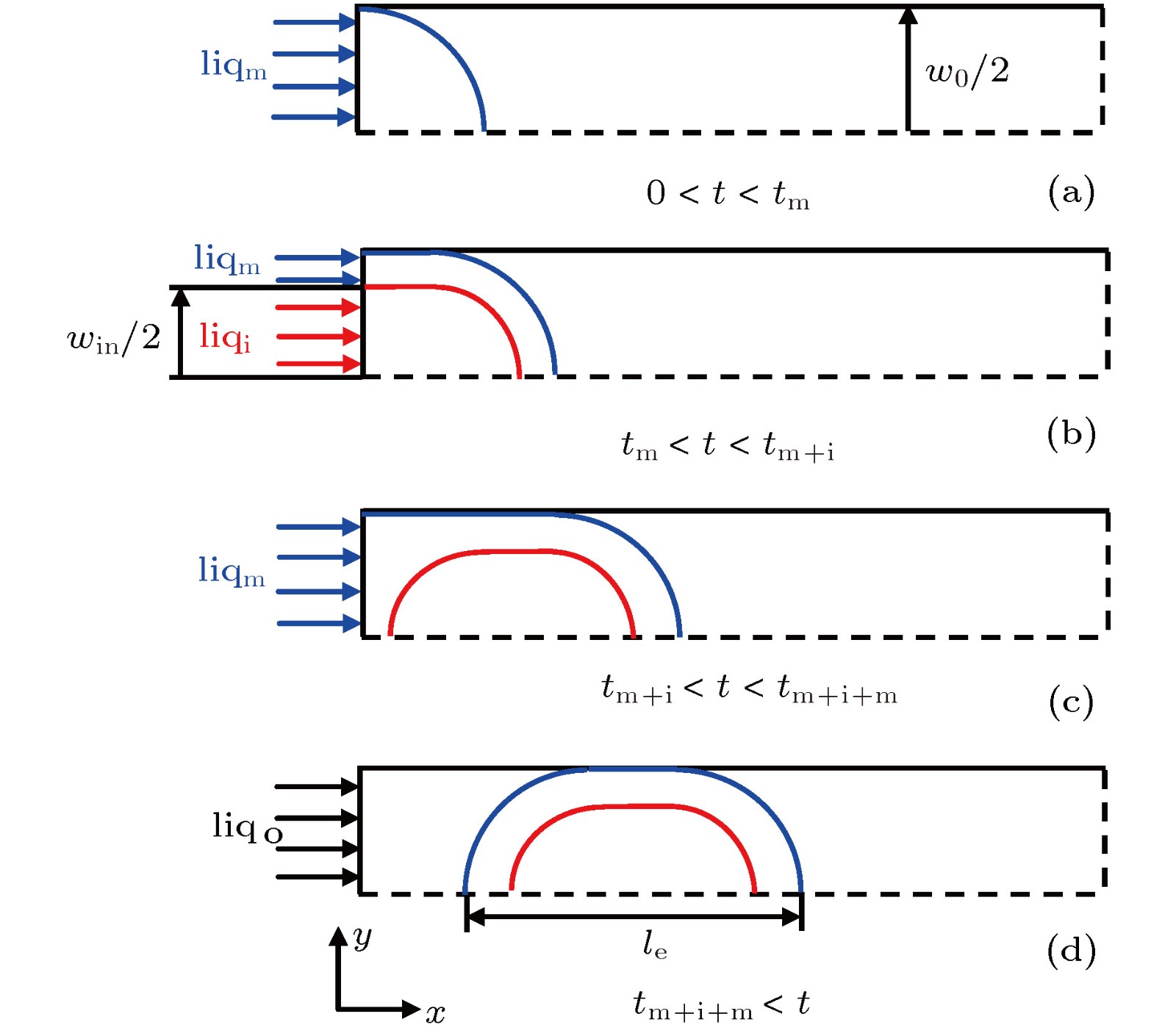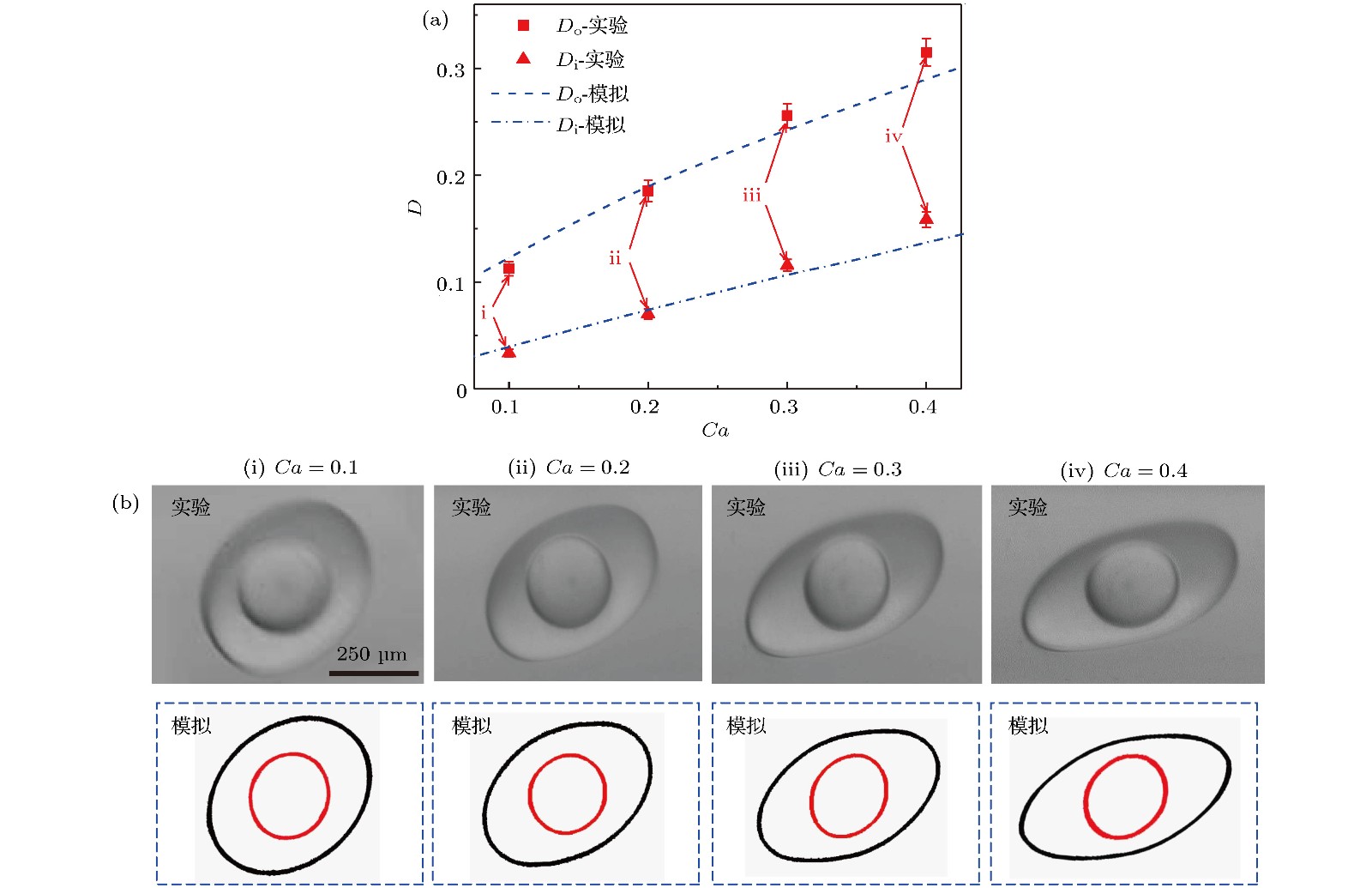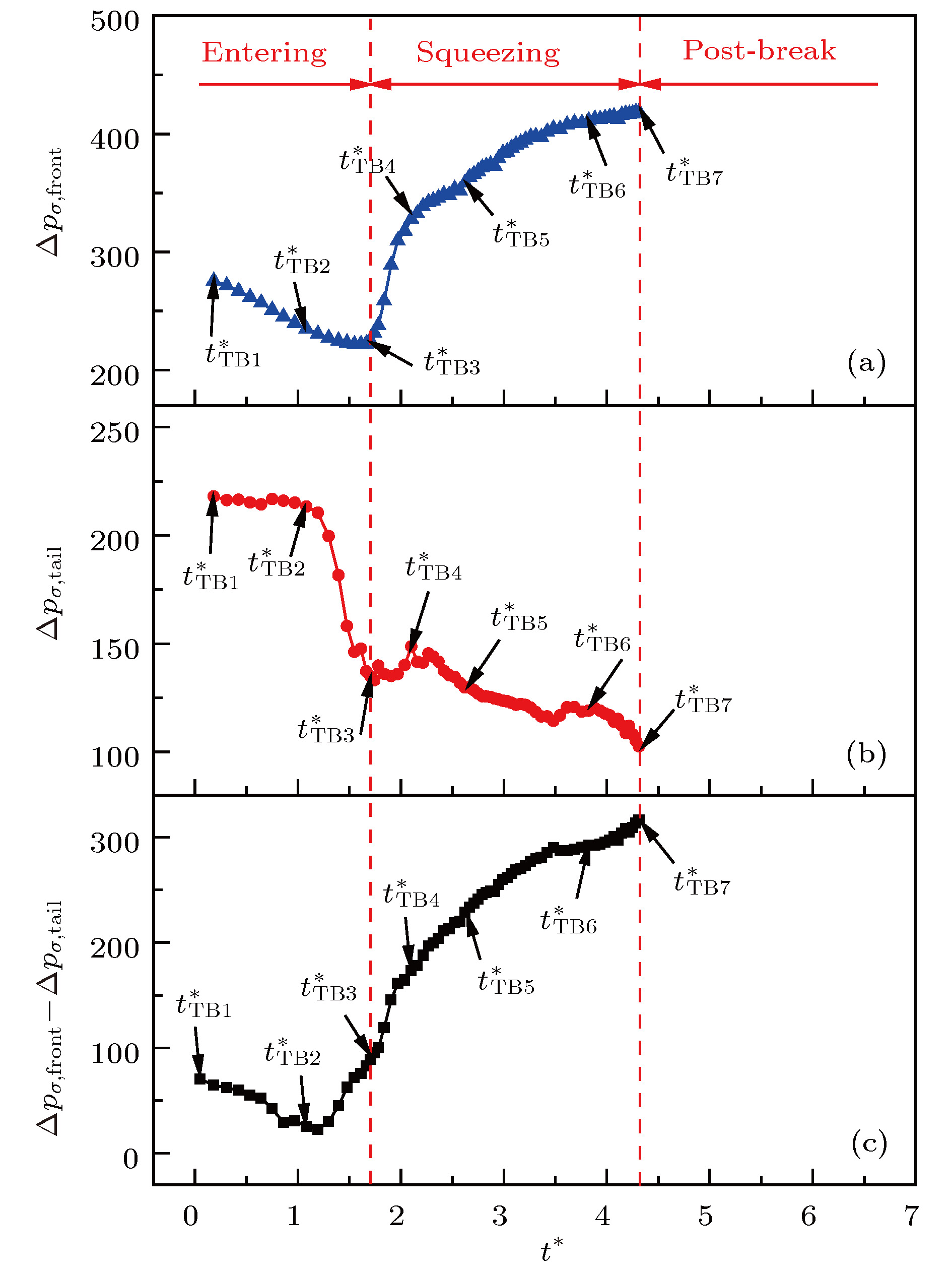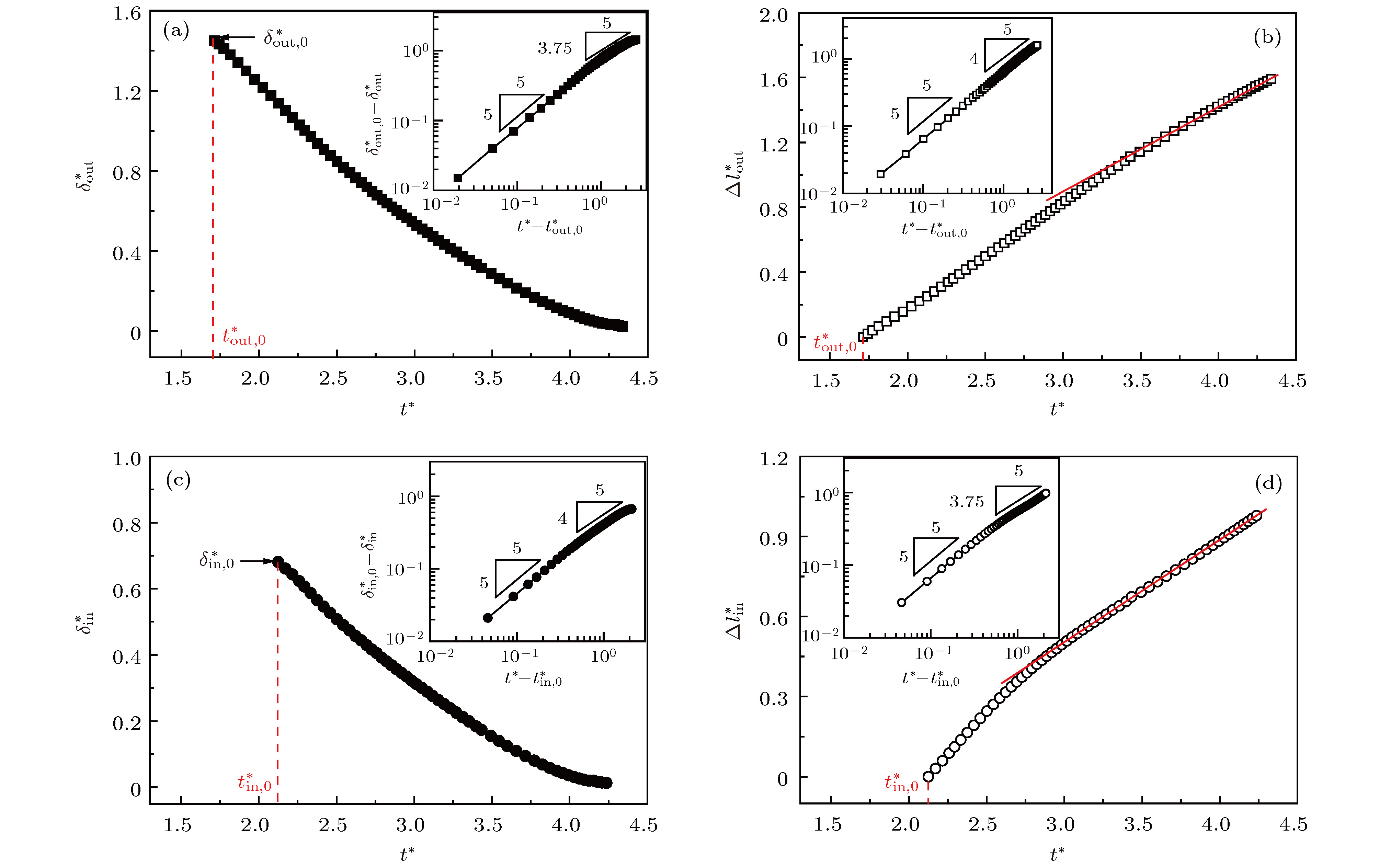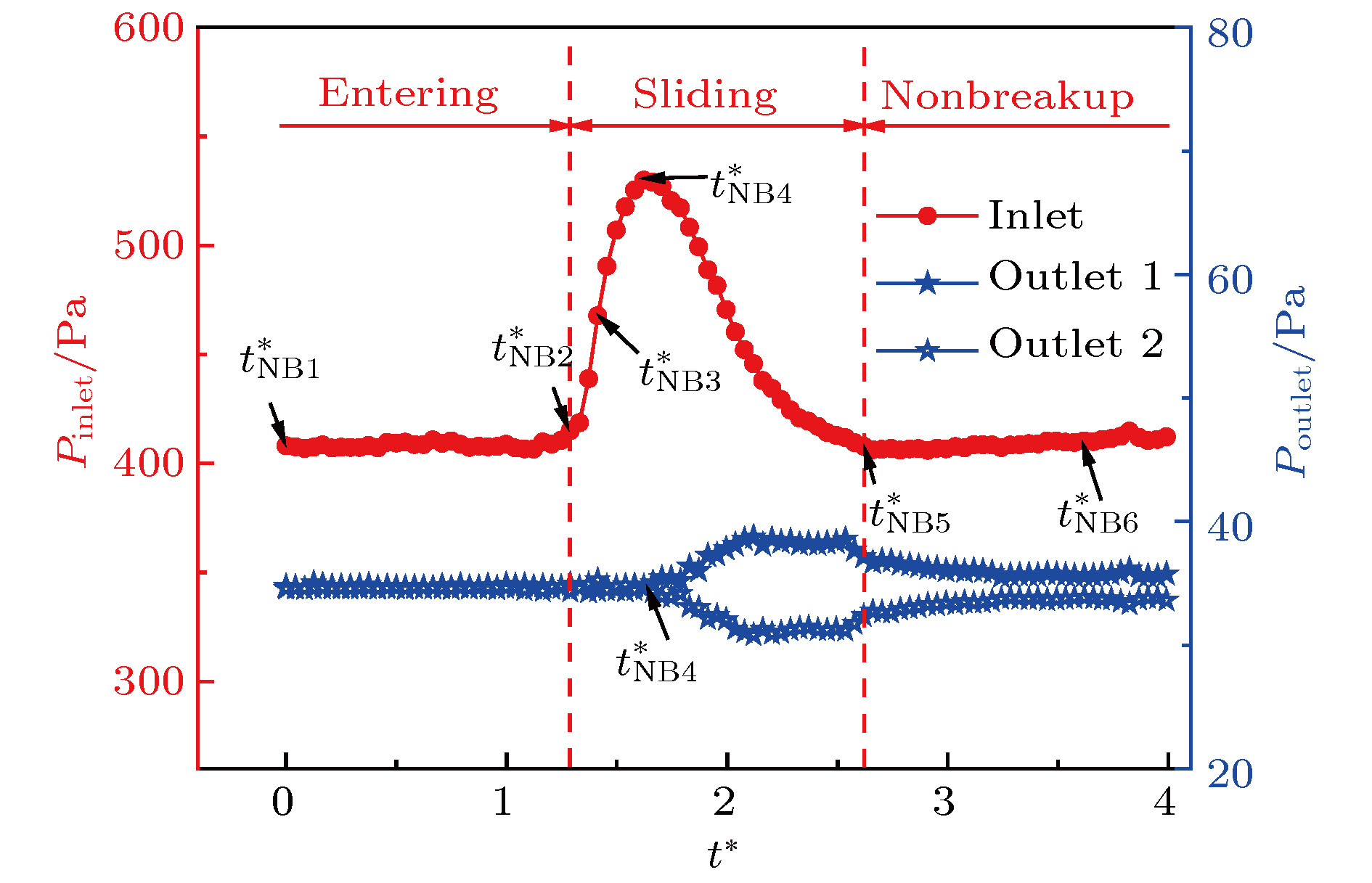-
A scheme of passive breakup of generated droplet into two daughter droplets in a microfluidic Y-junction is characterized by the precisely controlling the droplet size distribution. Compared with the T-junction, the microfluidic Y-junction is very convenient for droplet breakup and successfully applied to double emulsion breakup. Therefore, it is of theoretical significance and engineering value for fully understanding the double emulsion breakup in a Y-junction. However, current research mainly focuses on the breakup of single phase droplet in the Y-junction. In addition, due to structural complexity, especially the existence of the inner droplet, more complicated hydrodynamics and interface topologies are involved in the double emulsion breakup in a Y-junction than the scenario of the common single phase droplet. For these reasons, an unsteady model of a double emulsion passing through microfluidic Y-junction is developed based on the volume of fluid method and numerically analyzed to investigate the dynamic behavior of double emulsion passing through a microfluidic Y-junction. The detailed hydrodynamic information about the breakup and non-breakup is presented, together with the quantitative evolutions of driving and resistance force as well as the droplet deformation characteristics, which reveals the hydrodynamics underlying the double emulsion breakup. The results indicate that the three flow regimes are observed when double emulsion passes through a microfluidic Y-junction: obstructed breakup, tunnel breakup and non-breakup; as the capillary number or initial length of the double emulsion decreases, the flow regime transforms from tunnel breakup to non-breakup; the upstream pressure and the Laplace pressure difference between the forefront and rear droplet interfaces, which exhibit a correspondence relationship, are regarded as the main driving force and the resistance to double emulsion breakup through a microfluidic Y-junction; the appearance of tunnels affects the double emulsion deformation, resulting in the slower squeezing speed and elongation speed of outer droplet as well as the slower squeezing speed of inner droplet; the critical threshold between breakup and non-breakup is approximately expressed as a power-law formula
${l^*} = \beta C{a^b}$ , while the threshold between tunnel breakup and obstructed breakup is approximately expressed as a linear formula${l^*} = \alpha $ ; comparing with the phase diagram for single phase droplet, the coefficients$\alpha $ and$\beta $ of the boundary lines between the different regimes in phase diagram for double emulsion are both increased.-
Keywords:
- Y-junction /
- double emulsion /
- breakup /
- volume of fluid method
[1] Shum H C, Bandyopadhyay A, Bose S, Weitz D A 2009 Chem. Mater. 21 5548
 Google Scholar
Google Scholar
[2] Chen H S, Zhao Y J, Li J, Guo M, Wan J D, Weitz D A, Stone H A 2011 Lab Chip 11 2312
 Google Scholar
Google Scholar
[3] Kim S H, Kim J W, Cho J C, Weitz D A 2011 Lab Chip 11 3162
 Google Scholar
Google Scholar
[4] Wang J, Sun L, Zou M, Gao W, Liu C, Shang L, Gu Z, Zhao Y 2017 Sci. Adv. 3 e1700004
[5] Kim J H, Jeon T Y, Choi T M, Shim T S, Kim S H, Yang S M 2014 Langmuir 30 1473
 Google Scholar
Google Scholar
[6] McClements D J, Li Y 2010 Adv. Colloid Interface Sci. 159 213
[7] Zhang Y, Chan H F, Leong K W 2013 Adv. Drug Del. Rev. 65 104
 Google Scholar
Google Scholar
[8] Teh S Y, Lin R, Hung L H, Lee A P 2008 Lab Chip 8 198
 Google Scholar
Google Scholar
[9] Seemann R, Brinkmann M, Pfohl T, Herminghaus S 2012 Rep. Prog. Phys. 75 016601
 Google Scholar
Google Scholar
[10] Shang L R, Cheng Y, Zhao Y J 2017 Chem. Rev. 117 7964
 Google Scholar
Google Scholar
[11] Choi C H, Kim J, Nam J O, Kang S M, Jeong S G, Lee C S 2014 Chemphyschem 15 21
 Google Scholar
Google Scholar
[12] Vladisavljevic G T, Al Nuumani R, Nabavi S A 2017 Micromachines 8 75
 Google Scholar
Google Scholar
[13] Cubaud T 2009 Phys. Rev. E 80 026307
 Google Scholar
Google Scholar
[14] Link D R, Anna S L, Weitz D A, Stone H A 2004 Phys. Rev. Lett. 92 054503
 Google Scholar
Google Scholar
[15] de Menech M 2006 Phys. Rev. E 73 031505
 Google Scholar
Google Scholar
[16] Jullien M C, Ching M J T M, Cohen C, Menetrier L, Tabeling P 2009 Phys. Fluids 21 072001
 Google Scholar
Google Scholar
[17] Leshansky A M, Pismen L M 2009 Phys. Fluids 21 023303
 Google Scholar
Google Scholar
[18] Afkhami S, Leshansky A M, Renardy Y 2011 Phys. Fluids 23 022002
 Google Scholar
Google Scholar
[19] Leshansky A M, Afkhami S, Jullien M C, Tabeling P 2012 Phys. Rev. Lett. 108 264502
 Google Scholar
Google Scholar
[20] Hoang D A, Portela L M, Kleijn C R, Kreutzer M T, van Steijn V 2013 J. Fluid Mech. 717 R4
 Google Scholar
Google Scholar
[21] Samie M, Salari A, Shafii M B 2013 Phys. Rev. E 87 053003
 Google Scholar
Google Scholar
[22] Chen B, Li G J, Wang W M, Wang P 2015 Appl. Therm. Eng. 88 94
 Google Scholar
Google Scholar
[23] Chen Y P, Deng Z L 2017 J. Fluid Mech. 819 401
 Google Scholar
Google Scholar
[24] Yamada M, Doi S, Maenaka H, Yasuda M, Seki M 2008 J. Colloid Interface Sci. 321 401
 Google Scholar
Google Scholar
[25] Carlson A, Do Quang M, Amberg G 2010 Int. J. Multiphase Flow 36 397
 Google Scholar
Google Scholar
[26] Abate A R, Weitz D A 2011 Lab Chip 11 1911
 Google Scholar
Google Scholar
[27] 梁宏, 柴振华, 施保昌 2016 物理学报 65 204701
 Google Scholar
Google Scholar
Liang H, Chai Z H, Shi B C 2016 Acta Phys. Sin. 65 204701
 Google Scholar
Google Scholar
[28] Wang Y, Minh D Q, Amberg G 2016 Phys. Fluids 28 033103
 Google Scholar
Google Scholar
[29] Zheng M M, Ma Y L, Jin T M, Wang J T 2016 Microfluid. Nanofluid. 20 107
 Google Scholar
Google Scholar
[30] Ma Y L, Zheng M M, Bah M G, Wang J T 2018 Chem. Eng. Sci. 179 104
 Google Scholar
Google Scholar
[31] Chen Y P, Gao W, Zhang C B, Zhao Y J 2016 Lab Chip 16 1332
 Google Scholar
Google Scholar
[32] Chen Y P, Liu X D, Shi M H 2013 Appl. Phys. Lett. 102 051609
 Google Scholar
Google Scholar
[33] Bashir S, Rees J M, Zimmerman W B 2014 Int. J. Multiphase Flow 60 40
 Google Scholar
Google Scholar
[34] Chen Y P, Wu L Y, Zhang L 2015 Int. J. Heat Mass Transfer 82 42
 Google Scholar
Google Scholar
[35] Nabavi S A, Gu S, Vladisavljevic G T, Ekanem E E 2015 J. Colloid Interface Sci. 450 279
 Google Scholar
Google Scholar
[36] Nabavi S A, Vladisavljevic G T, Gu S, Ekanem E E 2015 Chem. Eng. Sci. 130 183
 Google Scholar
Google Scholar
[37] Azarmanesh M, Farhadi M, Azizian P 2016 Phys. Fluids 28 032005
 Google Scholar
Google Scholar
[38] Fu Y H, Zhao S F, Bai L, Jin Y, Cheng Y 2016 Chem. Eng. Sci. 146 126
 Google Scholar
Google Scholar
[39] Liu X D, Wu L Y, Zhao Y J, Chen Y P 2017 Colloids Surf. Physicochem. Eng. Aspects 533 87
 Google Scholar
Google Scholar
[40] Chen Y P, Liu X D, Zhao Y J 2015 Appl. Phys. Lett. 106 141601
 Google Scholar
Google Scholar
[41] 张程宾, 于程, 刘向东, 金瓯, 陈永平 2016 物理学报 65 204704
 Google Scholar
Google Scholar
Zhang C B, Yu C, Liu X D, Jin O, Chen Y P 2016 Acta Phys. Sin. 65 204704
 Google Scholar
Google Scholar
[42] Liu X D, Wang C Y, Zhao Y J, Chen Y P 2018 Chem. Eng. Sci. 183 215
 Google Scholar
Google Scholar
[43] Liu X D, Wang C Y, Zhao Y J, Chen Y P 2018 Int. J. Heat Mass Transfer 121 377
 Google Scholar
Google Scholar
[44] Brackbill J U, Kothe D B, Zemach C 1992 J. Comput. Phys. 100 335
 Google Scholar
Google Scholar
[45] Gueyffier D, Li J, Nadim A, Scardovelli R, Zaleski S 1999 J. Comput. Phys. 152 423
 Google Scholar
Google Scholar
[46] Taylor G I 1934 Proc. Roy. Soc. London Series A 146 501
 Google Scholar
Google Scholar
-
图 5 模拟结果与实验结果[41]对比 (a) 双重乳液的形变参数D随Ca的变化; (b) 双重乳液形貌对比
Figure 5. Comparison of steady deformation of double emulsion between simulation and experiment[41]: (a) Steady deformation of double emulsion in the function of Ca; (b) comparison of droplet morphology reconstructed from numerical simulation with experimental snapshots.
图 7 阻塞破裂工况乳液前端及尾部界面张力演化情况(Ca = 0.01, Voi = 1.3, l* = 2.1) (a) 乳液前端界面张力; (b) 乳液尾部界面张力; (c) 乳液前端与尾部界面张力之差; (d) 特征时刻乳液前端与尾部界面张力的示意图
Figure 7. Evolution of the pressure for obstructed breakup (Ca = 0.01, Voi = 1.3, l* = 2.1): (a) The Laplace pressure of the forefront droplet interface; (b) the Laplace pressure of the rear droplet interface; (c) the Laplace pressure difference between the forefront and rear droplet interfaces; (d) schematics of
$\Delta {p_{\sigma ,{\rm{front}}}}$ and$\Delta {p_{\sigma ,{\rm{tail}}}}$ at different times.图 9 双重乳液无量纲特征参数在squeezing阶段内演化情况 (Ca = 0.01, Voi = 1.3, l* = 2.1) (a)外液滴颈部厚度
$\delta _{{\rm{out}}}^*$ , 插图中给出了$\delta _{{\rm{out}},0}^{\rm{*}} - \delta _{{\rm{out}}}^*$ 与${t^*} - t_{{\rm{out}},0}^{\rm{*}}$ 的对数坐标图; (b) 外液滴前端运动距离$\Delta l_{{\rm{out}}}^*$ , 插图中给出了$\Delta l_{{\rm{out}}}^*$ 与${t^*} - t_{{\rm{out}},0}^{\rm{*}}$ 的对数坐标图; (c) 内液滴颈部厚度$\delta _{{\rm{in}}}^*$ , 插图中给出了$\delta _{{\rm{in}},0}^{\rm{*}} - \delta _{{\rm{in}}}^*$ 与${t^*} - t_{{\rm{in}},0}^{\rm{*}}$ 的对数坐标图; (d) 内液滴前端运动距离$\Delta l_{{\rm{in}}}^*$ , 插图中给出了$\Delta l_{{\rm{in}}}^*$ 与${t^*} - t_{{\rm{in}},0}^{\rm{*}}$ 的对数坐标图Figure 9. Evolution of the dimensionless characteristic parameters in the squeezing stage for obstructed breakup (Ca = 0.01, Voi = 1.3, l* = 2.1): (a)The neck thickness of outer droplet
$\delta _{{\rm{out}}}^*$ , inset is the same data as log($\delta _{{\rm{out}},0}^{\rm{*}} - \delta _{{\rm{out}}}^*$ ) versus log(${t^*} - t_{{\rm{out}},0}^{\rm{*}}$ ); (b) the distance travelled by the tip of outer droplet$\Delta l_{{\rm{out}}}^*$ , the same data as log($\Delta l_{{\rm{out}}}^*$ ) versus log(${t^*} - t_{{\rm{out}},0}^{\rm{*}}$ ); (c) the neck thickness of inner droplet$\delta _{{\rm{in}}}^*$ , inset is the same data as log($\delta _{{\rm{in}},0}^{\rm{*}} - \delta _{{\rm{in}}}^*$ ) versus log(${t^*} - t_{{\rm{in}},0}^{\rm{*}}$ ); (b) the distance travelled by the tip of inner droplet$\Delta l_{{\rm{in}}}^*$ , the same data as log($\Delta l_{{\rm{in}}}^*$ ) versus log(${t^*} - t_{{\rm{in}},0}^{\rm{*}}$ ).图 11 隧道破裂工况乳液前端及尾部界面张力演化情况 (Ca = 0.01, Voi = 1.3, l* = 1.3) (a) 乳液前端界面张力; (b) 乳液尾部界面张力; (c) 乳液前端与尾部界面张力之差
Figure 11. Evolution of the pressure for tunnel breakup (Ca = 0.01, Voi = 1.3, l* = 1.3): (a) The Laplace pressure of the forefront droplet interface; (b) the Laplace pressure of the rear droplet interface; (c) the Laplace pressure difference between the forefront and rear droplet interfaces.
图 13 隧道破裂工况双重乳液无量纲特征参数在squeezing 阶段内演化情况 (Ca = 0.01, Voi = 1.3, l* = 1.3) (a) 外液滴颈部厚度
$\delta _{{\rm{out}}}^*$ , 插图中给出了$\delta _{{\rm{out}},0}^{\rm{*}} - \delta _{{\rm{out}}}^*$ 与${t^*} - t_{{\rm{out}},0}^{\rm{*}}$ 的对数坐标图; (b) 外液滴前端运动距离$\Delta l_{{\rm{out}}}^*$ , 插图中给出了$\Delta l_{{\rm{out}}}^*$ 与${t^*} - t_{{\rm{out}},0}^{\rm{*}}$ 的对数坐标图; (c) 内液滴颈部厚度$\delta _{{\rm{in}}}^*$ , 插图中给出了$\delta _{{\rm{in}},0}^{\rm{*}} - \delta _{{\rm{in}}}^*$ 与${t^*} - t_{{\rm{in}},0}^{\rm{*}}$ 的对数坐标图; (d) 内液滴前端运动距离$\Delta l_{{\rm{in}}}^*$ , 插图中给出了$\Delta l_{{\rm{in}}}^*$ 与${t^*} - t_{{\rm{in}},0}^{\rm{*}}$ 的对数坐标图Figure 13. Evolution of the dimensionless characteristic parameters in the squeezing stage for tunnel breakup (Ca = 0.01, Voi = 1.3, l* = 1.3): (a) The neck thickness of outer droplet
$\delta _{{\rm{out}}}^*$ , inset is the same data as log($\delta _{{\rm{out}},0}^{\rm{*}} - \delta _{{\rm{out}}}^*$ ) versus log(${t^*} - t_{{\rm{out}},0}^{\rm{*}}$ ); (b) the distance travelled by the tip of outer droplet$\Delta l_{{\rm{out}}}^*$ , the same data as log($\Delta l_{{\rm{out}}}^*$ ) versus log(${t^*} - t_{{\rm{out}},0}^{\rm{*}}$ ); (c) the neck thickness of inner droplet$\delta _{{\rm{in}}}^*$ , inset is the same data as log($\delta _{{\rm{in}},0}^{\rm{*}} - \delta _{{\rm{in}}}^*$ ) versus log(${t^*} - t_{{\rm{in}},0}^{\rm{*}}$ ); (b) the distance travelled by the tip of inner droplet$\Delta l_{{\rm{out}}}^*$ , the same data as log($\Delta l_{{\rm{in}}}^*$ ) versus log(${t^*} - t_{{\rm{in}},0}^{\rm{*}}$ ).表 1 数值模拟中各相流体的物性参数
Table 1. The properties of the fluids used for numerical simulation.
相 密度/kg·m–3 黏度/mPa·s 内相 1107 7.91 中间相 940 10.37 外相 1012 1.24 -
[1] Shum H C, Bandyopadhyay A, Bose S, Weitz D A 2009 Chem. Mater. 21 5548
 Google Scholar
Google Scholar
[2] Chen H S, Zhao Y J, Li J, Guo M, Wan J D, Weitz D A, Stone H A 2011 Lab Chip 11 2312
 Google Scholar
Google Scholar
[3] Kim S H, Kim J W, Cho J C, Weitz D A 2011 Lab Chip 11 3162
 Google Scholar
Google Scholar
[4] Wang J, Sun L, Zou M, Gao W, Liu C, Shang L, Gu Z, Zhao Y 2017 Sci. Adv. 3 e1700004
[5] Kim J H, Jeon T Y, Choi T M, Shim T S, Kim S H, Yang S M 2014 Langmuir 30 1473
 Google Scholar
Google Scholar
[6] McClements D J, Li Y 2010 Adv. Colloid Interface Sci. 159 213
[7] Zhang Y, Chan H F, Leong K W 2013 Adv. Drug Del. Rev. 65 104
 Google Scholar
Google Scholar
[8] Teh S Y, Lin R, Hung L H, Lee A P 2008 Lab Chip 8 198
 Google Scholar
Google Scholar
[9] Seemann R, Brinkmann M, Pfohl T, Herminghaus S 2012 Rep. Prog. Phys. 75 016601
 Google Scholar
Google Scholar
[10] Shang L R, Cheng Y, Zhao Y J 2017 Chem. Rev. 117 7964
 Google Scholar
Google Scholar
[11] Choi C H, Kim J, Nam J O, Kang S M, Jeong S G, Lee C S 2014 Chemphyschem 15 21
 Google Scholar
Google Scholar
[12] Vladisavljevic G T, Al Nuumani R, Nabavi S A 2017 Micromachines 8 75
 Google Scholar
Google Scholar
[13] Cubaud T 2009 Phys. Rev. E 80 026307
 Google Scholar
Google Scholar
[14] Link D R, Anna S L, Weitz D A, Stone H A 2004 Phys. Rev. Lett. 92 054503
 Google Scholar
Google Scholar
[15] de Menech M 2006 Phys. Rev. E 73 031505
 Google Scholar
Google Scholar
[16] Jullien M C, Ching M J T M, Cohen C, Menetrier L, Tabeling P 2009 Phys. Fluids 21 072001
 Google Scholar
Google Scholar
[17] Leshansky A M, Pismen L M 2009 Phys. Fluids 21 023303
 Google Scholar
Google Scholar
[18] Afkhami S, Leshansky A M, Renardy Y 2011 Phys. Fluids 23 022002
 Google Scholar
Google Scholar
[19] Leshansky A M, Afkhami S, Jullien M C, Tabeling P 2012 Phys. Rev. Lett. 108 264502
 Google Scholar
Google Scholar
[20] Hoang D A, Portela L M, Kleijn C R, Kreutzer M T, van Steijn V 2013 J. Fluid Mech. 717 R4
 Google Scholar
Google Scholar
[21] Samie M, Salari A, Shafii M B 2013 Phys. Rev. E 87 053003
 Google Scholar
Google Scholar
[22] Chen B, Li G J, Wang W M, Wang P 2015 Appl. Therm. Eng. 88 94
 Google Scholar
Google Scholar
[23] Chen Y P, Deng Z L 2017 J. Fluid Mech. 819 401
 Google Scholar
Google Scholar
[24] Yamada M, Doi S, Maenaka H, Yasuda M, Seki M 2008 J. Colloid Interface Sci. 321 401
 Google Scholar
Google Scholar
[25] Carlson A, Do Quang M, Amberg G 2010 Int. J. Multiphase Flow 36 397
 Google Scholar
Google Scholar
[26] Abate A R, Weitz D A 2011 Lab Chip 11 1911
 Google Scholar
Google Scholar
[27] 梁宏, 柴振华, 施保昌 2016 物理学报 65 204701
 Google Scholar
Google Scholar
Liang H, Chai Z H, Shi B C 2016 Acta Phys. Sin. 65 204701
 Google Scholar
Google Scholar
[28] Wang Y, Minh D Q, Amberg G 2016 Phys. Fluids 28 033103
 Google Scholar
Google Scholar
[29] Zheng M M, Ma Y L, Jin T M, Wang J T 2016 Microfluid. Nanofluid. 20 107
 Google Scholar
Google Scholar
[30] Ma Y L, Zheng M M, Bah M G, Wang J T 2018 Chem. Eng. Sci. 179 104
 Google Scholar
Google Scholar
[31] Chen Y P, Gao W, Zhang C B, Zhao Y J 2016 Lab Chip 16 1332
 Google Scholar
Google Scholar
[32] Chen Y P, Liu X D, Shi M H 2013 Appl. Phys. Lett. 102 051609
 Google Scholar
Google Scholar
[33] Bashir S, Rees J M, Zimmerman W B 2014 Int. J. Multiphase Flow 60 40
 Google Scholar
Google Scholar
[34] Chen Y P, Wu L Y, Zhang L 2015 Int. J. Heat Mass Transfer 82 42
 Google Scholar
Google Scholar
[35] Nabavi S A, Gu S, Vladisavljevic G T, Ekanem E E 2015 J. Colloid Interface Sci. 450 279
 Google Scholar
Google Scholar
[36] Nabavi S A, Vladisavljevic G T, Gu S, Ekanem E E 2015 Chem. Eng. Sci. 130 183
 Google Scholar
Google Scholar
[37] Azarmanesh M, Farhadi M, Azizian P 2016 Phys. Fluids 28 032005
 Google Scholar
Google Scholar
[38] Fu Y H, Zhao S F, Bai L, Jin Y, Cheng Y 2016 Chem. Eng. Sci. 146 126
 Google Scholar
Google Scholar
[39] Liu X D, Wu L Y, Zhao Y J, Chen Y P 2017 Colloids Surf. Physicochem. Eng. Aspects 533 87
 Google Scholar
Google Scholar
[40] Chen Y P, Liu X D, Zhao Y J 2015 Appl. Phys. Lett. 106 141601
 Google Scholar
Google Scholar
[41] 张程宾, 于程, 刘向东, 金瓯, 陈永平 2016 物理学报 65 204704
 Google Scholar
Google Scholar
Zhang C B, Yu C, Liu X D, Jin O, Chen Y P 2016 Acta Phys. Sin. 65 204704
 Google Scholar
Google Scholar
[42] Liu X D, Wang C Y, Zhao Y J, Chen Y P 2018 Chem. Eng. Sci. 183 215
 Google Scholar
Google Scholar
[43] Liu X D, Wang C Y, Zhao Y J, Chen Y P 2018 Int. J. Heat Mass Transfer 121 377
 Google Scholar
Google Scholar
[44] Brackbill J U, Kothe D B, Zemach C 1992 J. Comput. Phys. 100 335
 Google Scholar
Google Scholar
[45] Gueyffier D, Li J, Nadim A, Scardovelli R, Zaleski S 1999 J. Comput. Phys. 152 423
 Google Scholar
Google Scholar
[46] Taylor G I 1934 Proc. Roy. Soc. London Series A 146 501
 Google Scholar
Google Scholar
Catalog
Metrics
- Abstract views: 17841
- PDF Downloads: 147
- Cited By: 0



















 DownLoad:
DownLoad:
